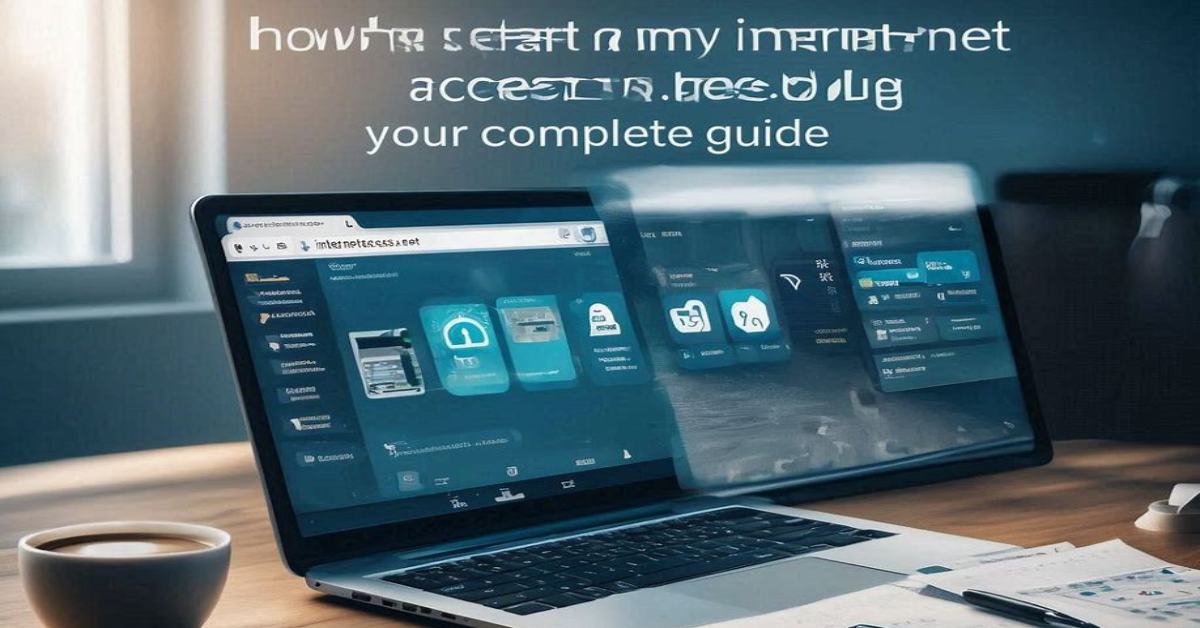How to Start MyInternetAccess.net Blog: Your Complete Guide
If you’re looking to start myinternetaccess.net blog, you’ve come to the right place. In this article we’ll walk through the full process — from planning your blog, choosing the right platform, setting up content and structure, optimizing for search engines (SEO), promoting your blog, and maintaining it for long-term success. By following these steps, you’ll ensure your blog stands out, provides value, and ranks well.
Why You Should Start MyInternetAccess Net
Before diving into the “how”, let’s consider the “why”. Choosing to start myinternetaccess net blog means you’re committing to creating a highquality resource about internet access, cybersecurity, tech trends, and smart living (which aligns with what MyInternetAccess focuses on). When you publish consistent, well-researched content, you build authority, trust, and an audience. This also forms a solid foundation for SEO, inbound traffic, and engagement.
Also Read: ireallyneeda5-com/
Here are some key benefits:
- Establish yourself (and your brand) as an expert in internet access & security.
- Target niche but increasingly important topics: cybersecurity, privacy, emerging networks — which the MyInternetAccess blog already covers.
- Create content that aligns with user intent — people searching “how to start myinternetaccess net blog” or “internet access tips” will find you.
- Build search-engine visibility over time with keyword-rich, helpful posts.
- Offer value to your readers — not just sales pitches — which enhances user experience and helps Google reward you.
Define Your Blog’s Focus & Structure
When you decide to start myinternetaccess net blog, you must define your target audience and the structure of your blog. Ask yourself:
- Who are we writing for? Beginners, tech-savvy users, business professionals?
- What specific topics will we address? (e.g., broadband access, router security, VPNs, smart-home connectivity, IoT implications)
- How often will we publish? Weekly, bi-weekly, monthly?
- How will the blog be organised? Will you have categories like “Cybersecurity”, “Home Internet & Smart Living”, “Connectivity Trends”?
For example, on MyInternetAccess.net you’ll find blog posts covering internet privacy, emerging networking trends, digital safety. Organising your blog into clear categories helps users find what they want, and helps search engines understand your topical focus.
When you start myinternetaccess.net blog, create a clear sitemap or navigation:
- Home
- Blog (all posts)
- Categories (e.g., Internet Privacy, Tech Trends, Smart Living)
- About Us
- Contact
This structure ensures both usability and SEO clarity.
Choose the Right Platform & Set Up Essentials
To start my internet net, you need to pick a blogging platform, set up hosting (if needed), choose a theme, and get foundational pages in place.
Platform & Hosting
- Use a reliable CMS (Content Management System) such as WordPress, or a hosted blog service if you prefer simplicity.
- Ensure your domain matches: you’ll likely use something like or a subdirectory.
- Choose hosting with good uptime, security features, and speed (Google considers page speed a ranking factor).
Theme & Design
Since MyInternetAccess emphasises usability and responsive design, your blog needs to reflect that. For instance, the blog emphasises mobile compatibility and user-friendly navigation.
- Choose a clean, minimalist design.
- Ensure responsive layout (desktop + mobile).
- Use clear typography and accessible colours.
- Add search functionality and category filters.
Essential Pages
Before publishing many posts, make sure you have:
- About page (who you are, why the blog exists).
- Contact page (so readers can get in touch).
- Privacy Policy & Terms (important for trust and compliance).
- Sitemap and navigation (for user experience and SEO).
Keyword Research & Content Planning
When you decide to start myinternetaccess.net blog, one of your first tasks is to perform keyword research and plan your content calendar. You want to target keywords that your audience uses — not just “myinternetaccess net blog” (which you’ll use for branding) but also related terms like “internet access tips”, “cybersecurity for home internet”, “how to secure your router”, etc.
Also Read: www-rewardsvbx-com/
Using the Main Keyword
Your brand keyword is “start myinternetaccess net blog”. Use it strategically:
- In your blog’s homepage title, meta description, and maybe once in the opening paragraph.
- In several posts (but avoid overusing it to the point of keyword stuffing).
- In internal links and anchor text when linking between posts.
Related Keywords & Topics
Use tools (e.g., Google Keyword Planner, Ubersuggest) to find long-tail phrases such as:
- “How to set up secure home internet access”
- “Internet Privacy Tips 2025”
- “optimise broadband speed for streaming”
- “smart living internet of things security”
Plan at least 10–15 pillar posts and supporting content. For example:
- “Top 10 Home Internet Security Tips”
- “Beginner’s Guide to VPNs for Home Use”
- “How to Optimise Your WiFi for Smart-Home Devices”
- “What to Know Before Choosing a Broadband Plan”
- “Emerging Connectivity Trends: 5G, WiFi 6, IoT”
Then map out internal linking: each pillar post linking to related supporting posts, which helps both UX and SEO.
Writing High-Quality Content
Now we reach one of the most important steps: producing high-quality blog posts once you’ve decided to start myinternetaccess.net blog. Google’s guidelines emphasise E-A-T (Expertise, Authoritativeness, Trustworthiness) and helpful, user-centric content. So your posts should:
- Address the user’s query clearly and fully.
- Use trustworthy information (citing credible sources if needed).
- Be readable (short paragraphs, headings, bullet lists).
- Be unique and not just “fluffed up”.
- Include visuals (images, infographics) where helpful.
- Be properly formatted with H2/H3 headings, meta description, and alt text for images.
Here’s how you might structure a typical post:
Sample Post Structure
Title: How to Secure Your Home Internet in 2025
- Introduction (what the post covers)
- Heading H2: Why Home Network Security Matters
- Heading H2: Key Threats to Your Home Internet
- Sub-heading H3: Unsecured WiFi Routers
- Sub-heading H3: Smart Devices as Entry Points
- Sub-heading H3: Phishing & Remote Access Attacks
- Heading H2: 10 Practical Steps to Secure Your Network
- Use a strong router password
- Enable automatic firmware updates
- Use WPA3 or at least WPA2 encryption
- Disable remote admin access
- Set up a guest network for visitors
- Use a reputable VPN (explain VPN)
- Segment your smart devices from your main network
- Set up two-factor authentication for online accounts
- Regularly check for unknown devices on your network
- Educate household members on phishing and safe browsing
- Heading H2: Monitoring and Maintaining Your Network
- Heading H2: Conclusion (wrap up, call to action)
Within your posts, you should naturally include your main keyword “start myinternetaccess net blog” in a couple of places (but not force it unnaturally). For example:
If you’re looking to start myinternetaccess net blog, this guide will help you publish content that ranks and serves readers.
One of the first posts on your site after you start myinternetaccess net blog should cover.
By doing this, you reinforce your brand keyword while still serving real user intent.
On-Page SEO & Technical Setup
With content ready, when you start myinternetaccess.net blog, you must ensure the technical and on-page SEO is optimized.
On-Page SEO
- Title tag: include main keyword (if appropriate) and stay under ~60 characters.
- Meta description: compelling summary (under ~160 characters) that includes a keyword.
- URL / slug: keep it short and keyword-friendly.
- Heading tags: H1 for title, then H2/H3 as per structure.
- Keyword usage: use the keyword at least once in the intro, once in a heading (if natural), and a few times in the body (but avoid overuse).
- Internal links: link to other relevant posts on your blog (e.g., “See also: How to optimise your WiFi for smart-home devices”).
- External links: link to credible, authoritative sources (e.g., tech research, reputable blogs) to support claims.
- Images: add relevant images with descriptive file names and alt text (e.g., alt=”home wifi security tips”).
- Mobile-friendly: ensure site loads fast and is responsive — Google prioritises mobile-first indexing.
Technical & Site Performance
- Use SSL (HTTPS) — the padlock icon in the browser gives users and search engines confidence.
- Ensure fast load times (optimize images, use caching, consider CDN).
- Use a sitemap.xml and robots.txt and submit to Google Search Console.
- Ensure no duplicate content issues and canonical tags are used when needed.
- Structured data/schema markup (if you want to highlight blog posts, authors, dates).
- Enable comments (if you want engagement) but moderate to avoid spam — this can enhance trust and freshness.
Promote Your Blog & Build Authority
After you start myinternetaccess.net blog and publish your first content pieces, the next phase is promotion and authority building.
Social & Community
- Share each blog post on social media (LinkedIn, Twitter, Facebook) where your target audience hangs out.
- Engage in relevant forums or communities (like sub-forums about internet access, cybersecurity) and share helpful insights (with links back to your blog when appropriate).
- Encourage email sign-ups: consider a free downloadable checklist or guide (e.g., “Home Internet Security Checklist”) to build your list.
Guest Posting & Backlinks
- Write guest posts on relevant tech blogs/privacy & security sites, linking back to your blog — this helps authority and SEO.
- Collaborate with influencers in the niche (cybersecurity experts, smart home bloggers) and ask for mentions or interviews.
- Monitor online mentions of your blog and encourage linking (use tools like Ahrefs or Google Alerts).
Consistency & Engagement
- Publish posts on a consistent schedule (e.g., weekly). Regular updates help search engines see your site as active and valuable.
- Enable comments and respond to them — user engagement can help with dwell time and community building.
- Use analytics (Google Analytics) to track which posts perform well and why — then replicate that success.
Monitor, Improve & Maintain
Once you’ve launched your blog and have some posts live, ongoing maintenance is key. When you start myinternetaccess.net blog, you’re in for a journey — not a one-time task.
Monitoring
- Track traffic, bounce rate, and average session duration via analytics.
- Use Google Search Console to monitor search impressions, clicks, and indexing issues.
- Monitor for broken links and remove or redirect them.
- Check load times periodically and optimize as needed.
Updating Content
- Tech and internet access topics move fast. Update older posts when new developments occur (e.g., new WiFi standards, security threats).
- Refresh high-performing posts with added value (new stats, visuals, updated steps) to keep them ranking.
- Remove or merge low-performing posts that don’t serve your audience or align with your focus.
Technical Audits
- Every few months, run an SEO audit for site speed, mobile usability, and crawl errors.
- Review and update plugins/themes (if using WordPress) to keep the site secure.
- Back up your site regularly and ensure security measures are in place.
Frequently Asked Questions (FAQs)
When I start my internet blog, how often should I publish new posts?
Ideally, publish at least once a week in the beginning. A frequent schedule helps build habit, content depth, and signals to search engines that your blog is active.
Can I use guest authors on my blog when I start my internet net blog?
Yes. Guest authors can bring fresh perspectives, expertise, and new audiences to your blog. Just ensure their content matches your quality standards and aligns with your topics.
How long before I see traffic after I start my internet net blog?
Traffic growth varies. Typically, you can expect to see some search-driven traffic after 3–6 months if you publish consistent, high-quality content and establish authority through backlinks.
Do I need to pay for advertising when I start my internet net blog?
No, not initially. Organic SEO, social media sharing, and community engagement can drive traffic. Paid advertising can be considered later when you want to scale or promote specific content.
How do I measure success after I start my internet net blog?
Use metrics like: search impressions & clicks (via Search Console), organic traffic growth, time on page, bounce rate, number of comments/shares, email sign-ups, and conversions (if applicable). These indicate both SEO health and user engagement.
Conclusion
Setting out to start myinternetaccess.net blog is an exciting step. With the right planning, content strategy, SEO efforts, promotion, and maintenance, your blog can become a trusted resource in the field of internet access, cybersecurity and smart living. Remember: quality matters. Google rewards content that genuinely helps users. Focus on your audience, be consistent, and your blog will grow.
By following the steps above — define your focus, set up your platform, engage in keyword research, write useful content, optimise on-page, promote your posts, and maintain your site — you’ll position your blog for long-term success. So go ahead, start myinternetaccess.net blog today, and let your content shine.
Also Read:
- Markyystreams: A Complete 2025 Guide to Free Sports Streaming
- Renvoit com: The Ultimate Digital Platform for Innovation, Technology, and Lifestyle
- Kipflix: The Ultimate Guide to Free Legal Streaming in 2025
- Waters CryptoProNetworkCom: The Future of Smart Crypto Investments
- From Blog Titaniumshare: A Complete Guide for Modern Bloggers







